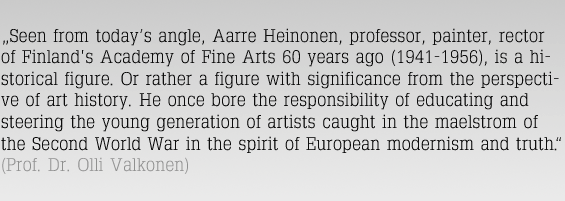




Aarre Heinonen's own development stemmed from his difficult career, so characteristic of multitalented people. His music studies in Vyborg and Helsinki had qualified him as a music teacher and he was also an accomplished pianist. His long-term interest in painting, however, eventually won. His painting studies proper started after his first solo exhibition at the age of 25 in the drawing hall of the University of Helsinki under the guidance of Väinö Blomstedt. The Ateneum's Academy of Art was not an option for him at that time but he went on - just like Edelfelt - to the Antwerp Royal Academy of Fine Arts 1935-37 and thereafter to Paris. Heinonen's career development marked a departure from the attitude then prevalent among young artists who feared that too much "academia" poised a threat to their freedom of artistic expression. The pressing question was, as ever, how the artist's training or art education should be organised to better correspond to its purpose.
Students develop according to their abilities, some more, some less, depending on the teaching they receive. Later, the significance of the school or teacher loses significance, and only the community and the working atmosphere at the school amounts to anything. The fact that it is usually the teacher with a sense of responsibility who creates the atmosphere often goes unnoticed.
Aarre Heinonen was well suited to the managerial tasks of the Academy. He had a versatile artistic education and had independently widened his cultural knowledge. Therefore, it can be said that he was highly competent as an artist, both in theory and in practice. In addition, his personal characteristics made him an excellent choice for PR tasks, which he often performed. Post-war Finland moulded him into an ambassador of art, just as Edelfelt had been. A polyglot, who excelled in the cultured circles, a useful figure to have around to tackle international relations, Aarre Heinonen participated in negotiations, frequented diplomatic parties as a guest and hosted artists' meetings. His tour as a comissioner of Finnish art across Europe via Brussels, Hague, Prague, Warsaw, Zürich, Florence and Paris between 1949 and 1950 was of national significance.
Aarre Heinonen's work is built on the foundation of 1920s moderate modernism. It was closely related to some French artist's endeavours to steer picturesqueness in a freer direction and more refined use of colours. With impressionism as its point of departure, the trend had developed towards abstract artistic expression untouched by radical expressionism and cubism. The essential feature of this technique was the concentration on spontaneous brush technique, for example, in landscapes or on aesthetic elegance in still lifes. From the trend represented by Bonnard, Brianchon and Oudot, Heinonen developed his own picturesque style, which he also conveyed to the works of his students, the talented artist generation of the 1950s.
Controlled and harmonious, Aarre Heinonen's work extends over decades in the form of landscapes, portraits, drawings and the compositions featuring people. Change is not an emblematic feature of his art; he chose his direction ages ago. His art lives in its own time and is of its own kind. The contemporary trends, both valuable and worthless, of today or even yesterday have not affected it. The vitality of his art is a good reminder that there are certain permanent basic values in modernist painting.
Author:
Prof. Dr. Olli Valkonen (in a review marking the Heinonen Exhibition in the BE'19 Gallery from 4th to 18th of December 2002)
Translation:
Galleria BE'19










